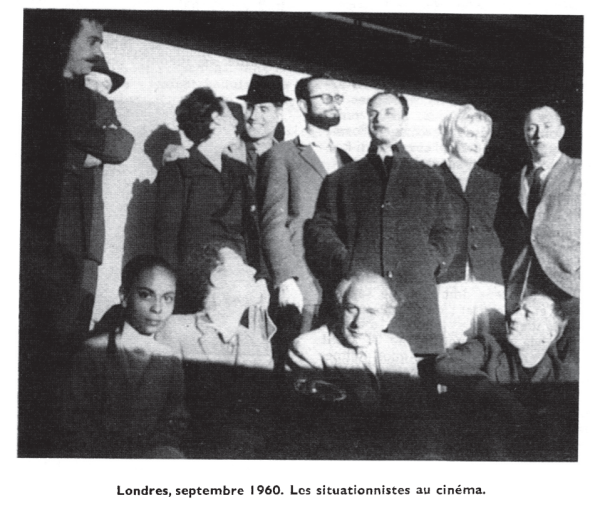From Internationale Situationniste #5 (December 1960).

One knows what the SI isn't; what terrain it elects not to occupy any longer (or only in a marginal way, in its struggles against all existing conditions). It is more difficult to say where the SI is headed, to positively characterize the situationist project. Nevertheless, one can delineate, albeit fragmentarily, certain provisional positions along its way.
Unlike the hierarchical bodies of specialists that increasingly make up the bureaucracies, the armies and even the political parties of the modern world, the SI, it will one day be seen, evinces itself as the purest form of an anti-hierarchical body of anti-specialists.
Situationist critique and construction concerns, at every level, the use value of life. Just as our conception of urbanism is a critique of urbanism; just as our experience of leisure is in fact a refusal of leisure (in the dominant sense of separation and passivity); our designation of everyday life as our field of action means a critique of everyday life, one that will have to be "radical critique accomplished, and no longer advocated or indicated" (Frankin, Programmatic Sketches), since this practical critique of everyday life must veer toward its sublation into the "everyday that has become impossible."
We do not claim to have invented extraordinary ideas within modern culture, but rather to have begun to draw attention to how extraordinary the nothingness of modern culture is. Specialists in cultural production are the ones who resign themselves most easily to their separation, and thus to their deficiency. But it is the whole of present society that cannot avoid the problem of the recuperation of its countless alienated, uncontrolled capabilities.
Abundance, as human becoming, could not be abundance of objects, even of "cultural" objects of the past or created on that model, but abundance of situations (of life, of the dimensions of life). Within the current framework of consumerist propaganda, the fundamental mystification of advertising is to associate ideas of fulfillment with objects (televisions, or garden furniture, or automobiles, etc.) and furthermore by destroying the natural link these objects may have with other objects, so as to have them above all become a material environment with "status." This imposed image of fulfillment also constitutes the explicitly terrorist nature of advertizing. Nevertheless, "fulfillment" (the moment of happiness) depends upon a global reality that involves nothing less than people in a given situation: living persons and the moment that gives them light and direction (their margin of possibility). In advertizing, objects are treated as embodying passion in a passionate way ("how changed your life will be when you own a marvelous car like this"). But anything that would be worthier of interest cannot be treated without endangering the condition of the whole: when advertizing busies itself with a real passion, this means only the advertizing of a spectacle.
The architecture still to be made must keep its distance from preoccupations with the spectacular beauty of the old monumental architecture, and must privilege topological organizations that command general participation. We will play on topophobia and create a topophilia. The situationist considers his environment and himself as plastic entities.
The new architecture shall undertake its first practical exercises with the detournment of once well-defined affective blocks of ambiance (the castle, for example). The use of detournement, in architecture as in the constructing of situations, signifies the reinvestment of products abstracted from the ends contemporary socio-economic organization gives them, and a break with the formalist wish to abstractly create the unknown. This means liberating existing desires at once, and deploying them within the new dimensions of an unknown actualization.
This is how researches toward a direct art of situations have recently and, no doubt, considerably advanced with the first outline of a basic notation of the lines of force of events within a projected situation. It is a matter of schemas, of equations in which the participants can choose which unknowns they are going to play, seriously, without spectators, and with no other goal than this game. Here, assuredly, is a prototype weapon that is effective in the struggle against alienation, useful in any event for breaking with the sad convention of libertinage; here is a first step forward along the Fourierist path of the "routes to fulfillment." It must be added that we do not affirm any desirable form or give any guarantee of fulfillment, and that these more or less precise and complete schemas can only serve as starting points, opened up by a calculated arrangement of events, for making a leap into the unknown. These schemas are, morover, an application of the situationist principle of the catapult, observed during the course of the derive of 29-31 May in Brussels and Amsterdam.
In this case, the experiment revealed that an extreme acceleration of the traversal of social space, organized temporarily and under utilitarian pretexts, has the effect of suddenly launching the subjects, at the moment the acceleration ceases, into a derive that can proceed at faster, newly-acquired speeds. Obviously the fact should not be overlooked that any experiment that may be set up on a restricted basis, despite its informational and propagandanist value — being only at the laboratory stage, at an infinitesimal point of social totality — will exhibit not only a difference in scale but also a difference in kind in relation to the future construction of life. But this laboratory is heir to all the creations of an exhausted cultural sphere, and it opens the way to their practical supersession.
Here, then, are the latest advance-posts of culture. Beyond them begins the conquest of everyday life.
Translated by Paul Hammond. From: https://www.cddc.vt.edu/sionline/si/frontier.html
Comments